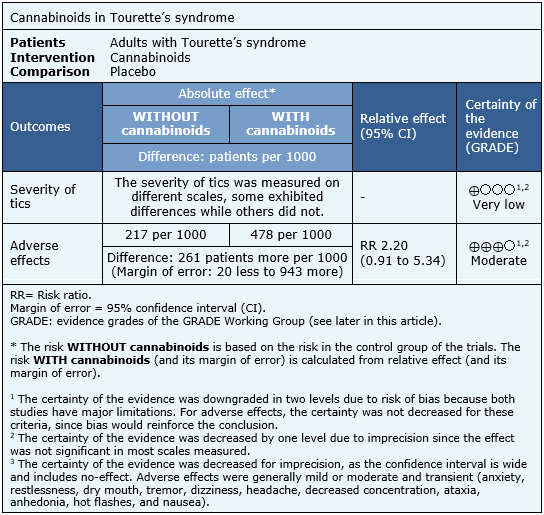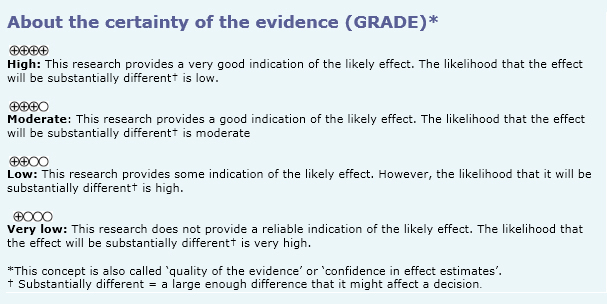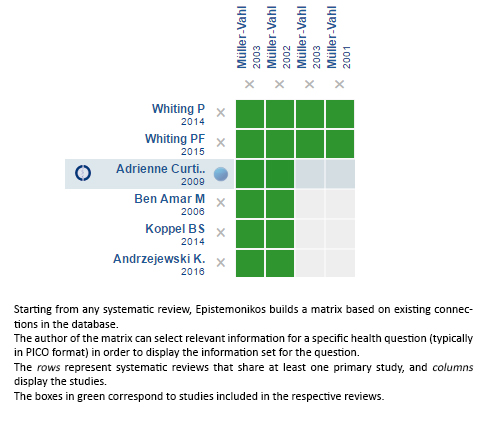Resúmenes Epistemonikos
← vista completaPublicado el 9 de diciembre de 2016 | http://doi.org/10.5867/medwave.2016.6793
¿Tienen algún rol los cannabinoides en el síndrome de Tourette?
Do cannabinoids have a role to play in Tourette’s syndrome?
Abstract
It has been suggested that the use of cannabinoids might play a role in the treatment of Tourette’s syndrome, but there is no consensus. Searching in Epistemonikos database, which is maintained by screening multiple databases, we identified seven systematic reviews including two randomized trials addressing the question of this article. We extracted data, combined the evidence using meta-analysis and generated a summary of findings following the GRADE approach. We concluded it is not clear whether cannabinoids reduce tics in Tourette’s syndrome, and they are probably associated to frequent adverse effects.
Problem
Tourette's syndrome is a neuropsychiatric disorder characterized by the presence of involuntary movements (motor tics) and vocalizations (vocal tics). In this condition, there is a lack of inhibition of neuronal cortico-striatal-thalamic-cortical circuits. Many drugs have been tried in order to reduce tics, with responses not entirely satisfactory. In the search for new therapies, the use of cannabinoids has been put forward, but there is no clear consensus about their clinical role.
Methods
We used Epistemonikos database, which is maintained by screening multiple databases, to identify systematic reviews and their included primary studies. With this information, we generated a structured summary using a pre-established format, which includes key messages, a summary of the body of evidence (presented as an evidence matrix in Epistemonikos), meta-analysis of the total of studies, a summary of findings table following the GRADE approach and a table of other considerations for decision-making.
|
Key messages
|
About the body of evidence for this question
|
What is the evidence. |
We found seven systematic reviews [1],[2],[3],[4],[5],[6],[7] including two randomized controlled trials reported in four references [8],[9],[10],[11]. |
|
What types of patients were included |
Both trials enrolled men and women diagnosed with Tourette’s syndrome based on DSM III criteria. |
|
What types of interventions were included |
Both trials evaluated the use of tetrahydrocannabinol capsules administered orally. In one trial, the dose was 5 mg, 7.5 mg or 10 mg once [9], and in the other trial, the dose was not specified [8]. Both trials compared against placebo. |
|
What types of outcomes |
The systematic reviews assessed the following outcomes:
|
* TSSL = Tourette's syndrome symptoms list; STSSS = Shapiro Tourette syndrome severity scale; YGTSS = Yale Global Tic Severity Scale; TSGS = Tourette's syndrome global scale; TSC-GI = Tourette's syndrome clinical global impression scale
Both trials evaluated the use of tetrahydrocannabinol capsules administered orally. In one trial, the dose was 5 mg, 7.5 mg or 10 mg once [9], and in the other trials, the dose was not specified [8].
Summary of findings
The Information on the effects of cannabinoids for Tourette’s syndrome is based on two randomized trials including 28 patients in total [8], [9]. Both trials measured the severity of tics, using different scales. The summary of findings is as follows:
Key messages
- It is not clear whether cannabinoids reduce tics in Tourette’s syndrome because the certainty of the evidence is very low.
- Cannabinoids are probably associated to frequent adverse effects. The certainty of the evidence is moderate.


Other considerations for decision-making
|
To whom this evidence does and does not apply |
|
| About the outcomes included in this summary |
|
| Balance between benefits and risks, and certainty of the evidence |
|
| What would patients and their doctors think about this intervention |
|
| Resource considerations |
|
|
Differences between this summary and other sources |
|
| Could this evidence change in the future? |
|
How we conducted this summary
Using automated and collaborative means, we compiled all the relevant evidence for the question of interest and we present it as a matrix of evidence.

Follow the link to access the interactive version: Cannabinoids for Tourette's syndrome
Notes
The upper portion of the matrix of evidence will display a warning of “new evidence” if new systematic reviews are published after the publication of this summary. Even though the project considers the periodical update of these summaries, users are invited to comment in Medwave or to contact the authors through email if they find new evidence and the summary should be updated earlier. After creating an account in Epistemonikos, users will be able to save the matrixes and to receive automated notifications any time new evidence potentially relevant for the question appears.
The details about the methods used to produce these summaries are described here http://dx.doi.org/10.5867/medwave.2014.06.5997.
Epistemonikos foundation is a non-for-profit organization aiming to bring information closer to health decision-makers with technology. Its main development is Epistemonikos database (www.epistemonikos.org).
These summaries follow a rigorous process of internal peer review.
Conflicts of interest
The authors do not have relevant interests to declare.

